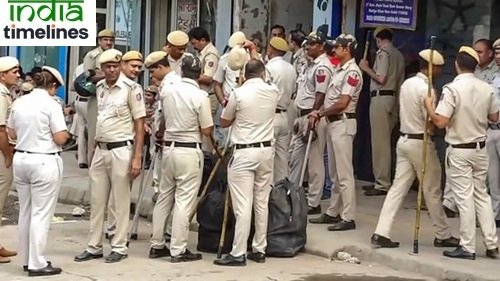
In a monumental crackdown, authorities in Delhi recently seized cocaine valued at an astounding ₹2,000 crore, marking the largest drug bust in the capital’s history. This massive haul is being hailed as a significant victory in India’s ongoing fight against drug trafficking and the illegal narcotics trade. The seizure not only highlights the increasing presence of high-value drugs in the region but also underscores the growing international drug smuggling networks targeting India as a transit and consumption hub.
The Operation: How the Bust Unfolded
Delhi police, in collaboration with central narcotics agencies, executed the operation following months of intelligence gathering. Acting on credible information, law enforcement officials launched a series of coordinated raids across different parts of the city. These efforts led to the seizure of over 500 kilograms of pure cocaine, packaged and hidden in an attempt to avoid detection. Authorities suspect that the drugs were part of a larger international smuggling operation, intended to be distributed both in India and abroad.
Several individuals, including suspected drug lords and couriers, have been detained for questioning. Initial reports suggest that the syndicate involved in the smuggling has ties to notorious international drug cartels, with operations spanning across multiple countries.
An International Network of Drug Smuggling
The scale of this seizure has raised concerns about the role of international drug cartels in India’s narcotics trade. Authorities believe that the cocaine was likely smuggled into India via maritime routes from South America, a continent that is home to some of the largest cocaine producers in the world. From there, the drugs are believed to have made their way to African countries before finally reaching India through a complex network of middlemen and traffickers.
India has increasingly become a target for international drug trafficking due to its geographical location and large, diverse population. The demand for drugs, particularly in metropolitan areas like Delhi, has risen, making the city a lucrative market for traffickers. This bust not only highlights the growing reach of these criminal organizations but also the sophisticated methods they employ to move such large quantities of drugs undetected.
The Impact on Delhi’s Drug Trade
Delhi, being one of India’s largest metropolitan areas, has seen a steady rise in the consumption of illegal drugs over the past few years. Cocaine, once considered a “party drug” reserved for the affluent, has found its way into various sections of society, fueling a burgeoning underground market. The recent bust is seen as a blow to this illegal trade, disrupting the supply chain that feeds the growing demand for narcotics in the city.
With the seizure of cocaine worth ₹2,000 crore, authorities have not only crippled the local distribution networks but have also sent a clear message to traffickers that law enforcement is actively working to curb drug-related activities. The financial loss to the drug cartels involved is immense, and the arrests made in connection with the bust could potentially lead to further revelations and subsequent crackdowns on similar operations.
India’s Growing Drug Problem
India’s drug problem has been escalating over the years, with the country emerging as both a major consumer and transit hub for narcotics. The sheer size of the recent cocaine haul highlights the scale of the issue. While drugs like cannabis and heroin have long been part of India’s illegal narcotics landscape, the emergence of high-value drugs such as cocaine points to a more significant and dangerous trend.
Authorities are particularly concerned about the impact of such drugs on the younger population. Drug addiction and substance abuse have been steadily rising among youth, particularly in urban centers like Delhi, Mumbai, and Bangalore. Cocaine, in particular, is highly addictive and can have devastating effects on individuals, leading to physical, mental, and social consequences. The rise in drug-related crimes is another alarming indicator of how the proliferation of narcotics is affecting society at large.
Law Enforcement’s Fight Against Drug Trafficking
This historic bust is part of a broader national effort to combat drug trafficking. Indian authorities have been ramping up their efforts to curb the inflow of illegal drugs into the country, particularly focusing on coastal security and international smuggling routes. Over the past few years, India has seen a number of high-profile drug seizures, especially in ports and airports, but the ₹2,000 crore cocaine bust is by far the largest in terms of value and volume.
Collaboration between local law enforcement, customs, and international narcotics control agencies has played a crucial role in making such operations successful. This recent bust is a testament to the effectiveness of coordinated intelligence sharing and the dedication of officers working on the ground.
The Legal Aftermath and What’s Next
Following the bust, those arrested will face a host of serious charges under the Narcotic Drugs and Psychotropic Substances (NDPS) Act, which includes severe penalties for drug smuggling and trafficking. If convicted, they could face life imprisonment or even the death penalty, depending on the scale and severity of their involvement.
Investigations are ongoing, and authorities are expected to make further arrests as they unravel the network behind this operation. The focus will now be on tracing the origins of the drug shipment, identifying the kingpins behind the operation, and dismantling the entire supply chain.
Conclusion: A Major Victory in the War on Drugs
The seizure of cocaine worth ₹2,000 crore is a landmark moment in Delhi’s battle against drug trafficking. This massive bust has not only disrupted a major smuggling operation but has also brought the issue of drug trafficking to the forefront of public consciousness. It serves as a stark reminder of the growing drug problem facing India and the importance of continued efforts by law enforcement to tackle this menace.
As the investigation continues, the hope is that this bust will lead to more breakthroughs in dismantling the broader drug trafficking network. For now, it stands as a major victory for Delhi’s law enforcement agencies and a significant step forward in India’s fight against the illegal narcotics trade.

































